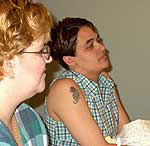By Brandt Williams
Minnesota Public Radio
July 1, 2002
As of July 1, about 1,000 Minnesota families reach the five-year limit on their welfare benefits. More than half of them will get an extension of benefits. And even those who are cut off from their cash benefits will continue to get food stamps and medical coverage. Still, social workers say some of these families may lose their homes without money to pay their rent. State and county officials say they won't know the impact of the deadline until perhaps months later.
| |
|
|
|
||
State and county human services officials say the welfare recipients hitting this first deadline are people who have spent the most time on the system. Most, like Tiffany McQueen, face barriers which prevent them from being self-sufficient.
"I had goals - man, I really wasn't supposed to be on welfare this long," says McQueen.
McQueen and three other women facing the end of their cash benefits are gathered at the Lifetrack Resource Center, an agency in St. Paul that helps people make the transition from welfare to self-sufficiency. She is 26, single, has four children and has been receiving welfare for nine years.
McQueen had hoped to become a nurse or a childcare provider. But she has a felony conviction, and McQueen says employers turn her down for those jobs when they find out about it. McQueen says she doesn't regret having her children - but she says she feels overwhelmed at times.
"I can't blame nobody for me having four kids, but it's something I gotta deal with," says McQueen. "It's hard. I get up every morning at 6:30, get my boys off to school, then take my daughters to daycare, then go to work, then come home. Then I gotta clean and cook - get them ready for bed. It's hard."
| |
|
|
|
||
Most of the women in the Lifetrack group have at least four children. A few say the fathers of their children are not paying them child support. Like all the women at the meeting, McQueen will get a benefits extension.
They all are enrolled in Lifetrack's intensive case management program. Just as the name suggests, the program focuses on those critical situations where a client faces the loss of benefits.
Tina Thompson heads the intensive case management program. Lifetrack handles more than 1,000 clients, but there are only 159 in the program.
"Eighty percent of the participants that we're serving will qualify for an extension category," Thompson says.
Last summer, the Minnesota Legislature decided that people with circumstances which make it harder for them to leave welfare after five years should get more time.
Tiffany McQueen will get an extension because she's involved in an employment program. Other women in the group are getting extensions because they've been abused by their partners, or because they've been diagnosed with depression. The extensions are indefinite as long as the person still qualifies.
| |
|
|
|
||
"Our typical participant has many, many issues they are facing. It's not just one or two - it's four or five or six or seven," says Thompson. "They're dealing with a language barrier. They're dealing with mental health, they may have a family member who's disabled or ill. They might have a child with learning disabilities - they may have a learning disability themselves."
Ramsey County and other counties across the state have prepared for the deadline by conducting exit interviews and assessments with welfare recipients. The interviews help social workers determine why certain clients have been in the welfare system so long. The interviews also revealed that the system has failed to address the needs of many of its clients.
"We need to identify some of these issues earlier," says Chuck Johnson of the state's Department of Human Services. "It doesn't make a lot of sense to be indentifying someone as mentally ill in month 56, when we could have done so much more if we'd known about it back in month six."
Johnson blames the old Aid to Families with Dependant Children program for some of the problems. AFDC was replaced by the Minnesota Family Investment Program in 1998. Johnson says AFDC just focused on getting people a check - not on making them self-sufficient.
|
"I had goals - man, I really wasn't supposed to be on welfare this long."
- Tiffany McQueen, welfare recipient |
Johnson credits MFIP - and a prosperous economy - for reducing the state's welfare roles by more than 30 percent over the last 10 years. But now the state's economy is in a downturn, and that could make it especially hard for families who don't qualify for an extension.
"This is the first time that we haven't had a safety net for families, and that's a big deal in my mind," says Martha Eaves, a lawyer with the legal aid office which serves Ramsey County and several other smaller counties in southwestern Minnesota. She has worked with welfare families for 26 years.
"It's one thing to say to a single adult person, 'We're not going to help you - go out and find a place to stay.' And we've seen what happens with that - if you drive by the (St. Paul) Civic Center and you go by Dorothy Day (homeless shelter), we see what has happened with that," says Eaves. "But it's not that easy for a family with children to survive, in the same way that a single adult can survive."
Eaves says for the last few weeks she has fielded dozens of calls from MFIP recipients who've recieved their final notices and haven't applied for an extension. She says her goal is to get an extension for anyone who qualifies. She says in some cases, legal action can be taken to stop a family from getting cut off.
Eaves also says she believes there will be many more who will need to be persuaded to seek help - by something stronger than a piece of mail.
"Sometimes if they get a notice from the welfare office and they're feeling depressed, they don't want to know," says Eaves. "It's like what people do when they have a bunch of bills and they just let the bills sit on the table. People will just let those notices sit on the table until they don't get their check or they don't get their cash in their account, and they'll do the call and say 'help me.'"
| |
|
|
|
||
Ramsey County officials say they expect more than half of their deadline cases to be granted extensions, and they expect more will apply for extensions after the cutoff. Hennepin County officials expect a little less than half of the more than 400 families on their deadline caseload will get extensions.
Deb Huskins heads Hennepin County's Economic Assistance Department. She says some families are in the process of trying to get extended, but haven't gotten their paperwork in yet. And there are others who've chosen not to participate in the assessment process.
"There's a lot of people who have not wanted to talk to the government about the issues going on in their family, and now they have to," says Huskins. "And that's unfortunate in some cases, because we could have helped them sooner."
Huskins says she understands why some people aren't willing to talk about personal information to a case worker, to whom they've only talked once or twice on the phone. She also expects that more of these people will apply for extensions after the deadline.
Some of the women at Lifetrack say the five-year limit is good, because it has helped motivate them to get off the system. But not Luann Hieb. Hieb has four children and has been on MFIP for five years, a period when she was taking care of her disabled mother and couldn't work outside the home. She's getting an extension because she is a victim of domestic abuse.
Hieb says there are some people who are only getting welfare because they refuse to work. However, she warns cutting people off welfare may lead to further problems.
"It's going to cause more trouble - people getting off - there's going to be so much more crime," says Hieb. "(There is) so much more stuff people are going to do trying to survive."
Eventually, all MFIP recipients who don't leave the system in five years will reach a deadline. However, state officials say the number of people who have stayed on MFIP long enough to face a cutoff represents less than three percent of their overall caseload.
More from MPRMore Information




